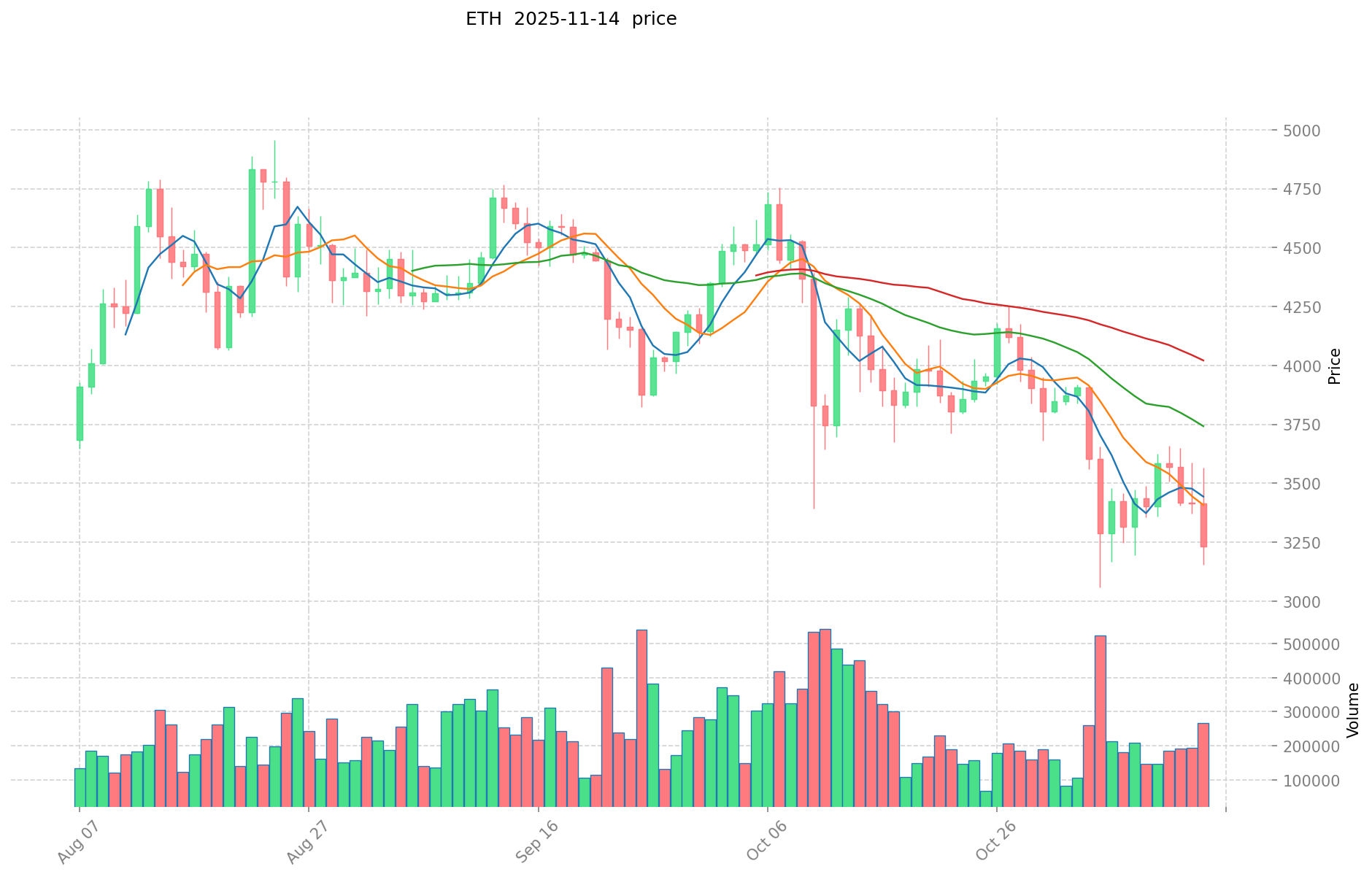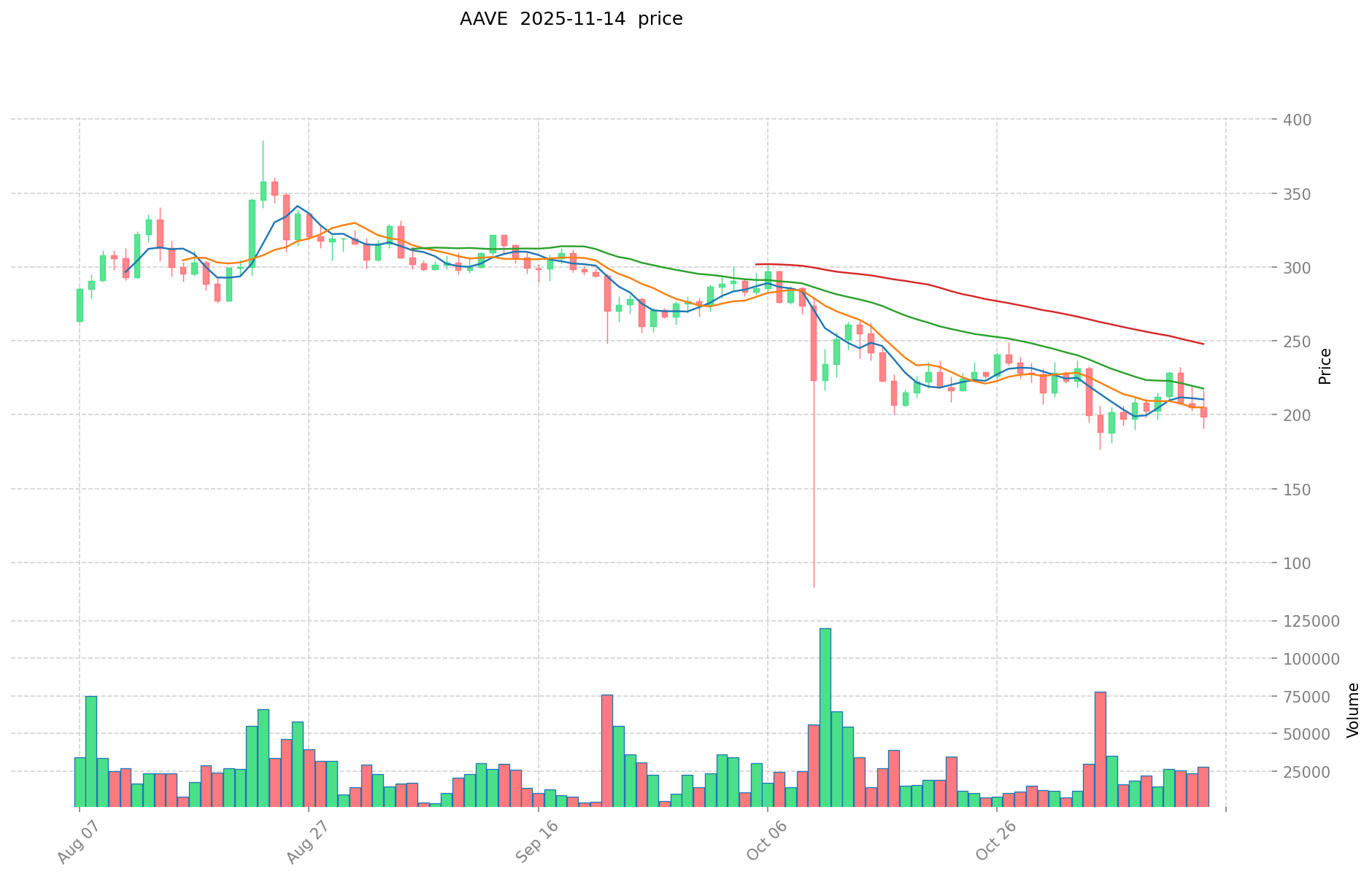ETH vs AAVE: Which Cryptocurrency Offers Better Long-Term Growth Potential?
Introduction: ETH vs AAVE Investment Comparison
In the cryptocurrency market, the comparison between Ethereum (ETH) and AAVE has always been a topic that investors cannot ignore. The two not only have significant differences in market cap ranking, application scenarios, and price performance, but also represent different positions in crypto assets.
Ethereum (ETH): Since its launch in 2015, it has gained market recognition for its support of smart contracts and decentralized applications (DApps).
AAVE (AAVE): Introduced in 2020, it has been hailed as a leading decentralized lending protocol, providing deposit and lending services to users.
This article will comprehensively analyze the investment value comparison between ETH and AAVE, focusing on historical price trends, supply mechanisms, institutional adoption, technical ecosystems, and future predictions, and attempt to answer the question that investors are most concerned about:
"Which is the better buy right now?"
I. Price History Comparison and Current Market Status
Ethereum (ETH) and AAVE Price History Trends
- 2020: AAVE was launched through the improvement proposal (AIP1) on October 3, 2020, converting LEND tokens to AAVE at a 100:1 ratio.
- 2021: ETH reached its all-time high of $4,946.05 on May 19, 2021, while AAVE hit its peak at $661.69 on the same date.
- Comparative analysis: During the market cycle, ETH dropped from its all-time high to a current price of $3,196.66, while AAVE declined from its peak to $187.94.
Current Market Situation (2025-11-14)
- ETH current price: $3,196.66
- AAVE current price: $187.94
- 24-hour trading volume: ETH $898,208,516.14 vs AAVE $6,635,781.87
- Market sentiment index (Fear & Greed Index): 16 (Extreme Fear)
Click to view real-time prices:
- View ETH current price Market Price
- View AAVE current price Market Price


II. Core Factors Affecting ETH vs AAVE Investment Value
Supply Mechanism Comparison (Tokenomics)
- ETH: Deflationary model after EIP-1559 implementation, with burning mechanism reducing supply over time
- AAVE: Fixed maximum supply of 16 million tokens with 13 million currently in circulation
- 📌 Historical Pattern: ETH's deflationary mechanism tends to create upward price pressure during high network activity, while AAVE's fixed supply model creates scarcity but depends more on protocol adoption and governance value.
Institutional Adoption and Market Applications
- Institutional Holdings: ETH is more widely held by institutions including Grayscale, Galaxy Digital and traditional finance companies entering the space; AAVE has less institutional backing but growing interest from DeFi-focused funds
- Enterprise Adoption: ETH serves as the backbone for thousands of DApps and enterprise blockchain solutions; AAVE primarily functions within the lending protocol ecosystem
- Regulatory Attitudes: ETH has generally received more regulatory clarity across jurisdictions; AAVE faces additional scrutiny as a DeFi lending protocol in some regions
Technical Development and Ecosystem Building
- ETH Technical Upgrades: Ongoing development toward Ethereum 2.0 with sharding planned to improve scalability; recent success with Layer 2 solutions
- AAVE Technical Development: Version 3 brought cross-chain functionality, improved risk management, and capital efficiency features
- Ecosystem Comparison: ETH supports the entire spectrum of DeFi, NFTs, gaming and enterprise applications; AAVE focuses specifically on lending markets but has expanded to multiple chains including Ethereum, Avalanche and Polygon
Macroeconomic Factors and Market Cycles
- Inflation Performance: ETH shows mixed inflation hedge properties but stronger than most altcoins; AAVE tends to correlate more with overall DeFi sector performance
- Monetary Policy Impact: Both assets show sensitivity to interest rate changes, with ETH demonstrating more resilience during tightening cycles
- Geopolitical Factors: ETH benefits from global adoption and censorship resistance; AAVE's cross-chain functionality helps mitigate regional regulatory risks III. 2025-2030 Price Prediction: ETH vs AAVE
Short-term Prediction (2025)
- ETH: Conservative $2,367.53 - $3,199.36 | Optimistic $3,199.36 - $3,519.30
- AAVE: Conservative $142.02 - $186.87 | Optimistic $186.87 - $269.09
Mid-term Prediction (2027)
- ETH may enter a bullish phase, with prices expected between $2,472.13 - $4,607.15
- AAVE may enter a growth phase, with prices expected between $180.90 - $380.16
- Key drivers: Institutional inflows, ETF developments, ecosystem growth
Long-term Prediction (2030)
- ETH: Base scenario $4,492.57 - $5,686.80 | Optimistic scenario $5,686.80 - $5,914.27
- AAVE: Base scenario $401.77 - $436.71 | Optimistic scenario $436.71 - $602.66
Disclaimer: This analysis is based on historical data and market projections. Cryptocurrency markets are highly volatile and unpredictable. This information should not be considered as financial advice. Always conduct your own research before making investment decisions.
ETH:
| 年份 | 预测最高价 | 预测平均价格 | 预测最低价 | 涨跌幅 |
|---|---|---|---|---|
| 2025 | 3519.296 | 3199.36 | 2367.5264 | 0 |
| 2026 | 4131.97344 | 3359.328 | 2687.4624 | 5 |
| 2027 | 4607.1503856 | 3745.65072 | 2472.1294752 | 17 |
| 2028 | 5262.264696528 | 4176.4005528 | 3382.884447768 | 30 |
| 2029 | 6654.25900077624 | 4719.332624664 | 4153.01270970432 | 47 |
| 2030 | 5914.2676452289248 | 5686.79581272012 | 4492.5686920488948 | 77 |
AAVE:
| 年份 | 预测最高价 | 预测平均价格 | 预测最低价 | 涨跌幅 |
|---|---|---|---|---|
| 2025 | 269.0928 | 186.87 | 142.0212 | 0 |
| 2026 | 296.37582 | 227.9814 | 216.58233 | 21 |
| 2027 | 380.1589845 | 262.17861 | 180.9032409 | 39 |
| 2028 | 391.825932645 | 321.16879725 | 250.511661855 | 70 |
| 2029 | 516.921179173875 | 356.4973649475 | 306.58773385485 | 89 |
| 2030 | 602.65879544374875 | 436.7092720606875 | 401.7725302958325 | 132 |
IV. Investment Strategy Comparison: ETH vs AAVE
Long-term vs Short-term Investment Strategies
- ETH: Suitable for investors focused on ecosystem potential and long-term growth
- AAVE: Suitable for investors interested in DeFi yield opportunities and protocol governance
Risk Management and Asset Allocation
- Conservative investors: ETH: 70% vs AAVE: 30%
- Aggressive investors: ETH: 60% vs AAVE: 40%
- Hedging tools: Stablecoin allocation, options, cross-asset portfolios
V. Potential Risk Comparison
Market Risks
- ETH: High correlation with overall crypto market sentiment
- AAVE: Vulnerability to DeFi sector-specific risks and market cycles
Technical Risks
- ETH: Scalability challenges, network congestion during high activity
- AAVE: Smart contract vulnerabilities, liquidity risks in extreme market conditions
Regulatory Risks
- Global regulatory policies may impact ETH less severely due to its established status, while AAVE faces more scrutiny as a DeFi lending protocol
VI. Conclusion: Which Is the Better Buy?
📌 Investment Value Summary:
- ETH advantages: Established ecosystem, deflationary mechanism, institutional adoption
- AAVE advantages: DeFi sector leader, cross-chain functionality, governance potential
✅ Investment Advice:
- New investors: Consider a higher allocation to ETH for broader market exposure
- Experienced investors: Balanced portfolio with both ETH and AAVE, leveraging DeFi opportunities
- Institutional investors: ETH as a core holding, AAVE as a strategic DeFi sector allocation
⚠️ Risk Warning: Cryptocurrency markets are highly volatile. This article does not constitute investment advice. None
VII. FAQ
Q1: What are the main differences between ETH and AAVE in terms of investment potential? A: ETH is the native token of the Ethereum network, serving as the backbone for thousands of DApps and enterprise blockchain solutions. It has a deflationary model and wider institutional adoption. AAVE, on the other hand, is a leading DeFi lending protocol token with a fixed supply, focusing specifically on lending markets and cross-chain functionality.
Q2: How do the supply mechanisms of ETH and AAVE differ? A: ETH follows a deflationary model after the implementation of EIP-1559, which includes a burning mechanism that reduces supply over time. AAVE has a fixed maximum supply of 16 million tokens, with 13 million currently in circulation.
Q3: Which asset is more suitable for long-term investment? A: ETH is generally considered more suitable for long-term investment due to its established ecosystem, ongoing technical developments (such as Ethereum 2.0), and broader market adoption. However, AAVE may offer significant long-term potential within the DeFi sector for investors interested in protocol governance and yield opportunities.
Q4: How do institutional adoption rates compare between ETH and AAVE? A: ETH has significantly higher institutional adoption, being widely held by institutions like Grayscale and Galaxy Digital, as well as traditional finance companies entering the crypto space. AAVE has less institutional backing but is gaining interest from DeFi-focused funds.
Q5: What are the main risks associated with investing in ETH and AAVE? A: For ETH, main risks include high correlation with overall crypto market sentiment, scalability challenges, and network congestion. AAVE faces risks such as vulnerability to DeFi sector-specific risks, smart contract vulnerabilities, and potential regulatory scrutiny as a lending protocol.
Q6: How might regulatory factors impact ETH and AAVE differently? A: ETH has generally received more regulatory clarity across jurisdictions due to its established status. AAVE, as a DeFi lending protocol, may face additional scrutiny in some regions, potentially impacting its adoption and use.
Q7: What allocation strategy would you recommend for a balanced crypto portfolio including ETH and AAVE? A: For a balanced portfolio, conservative investors might consider allocating 70% to ETH and 30% to AAVE, while more aggressive investors could opt for a 60% ETH and 40% AAVE split. However, individual allocations should be based on personal risk tolerance and investment goals.
Share
Content